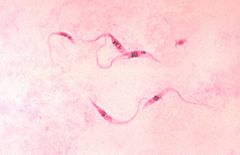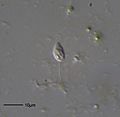Kinetoplastid facts for kids
Quick facts for kids Kinetoplastids |
|
|---|---|
 |
|
| Trypanosoma cruzi parasites | |
| Scientific classification | |
| Domain: | |
| Kingdom: | |
| Phylum: | |
| Class: |
Kinetoplastida
|
| Orders | |
|
Trypanosomatida |
|
The kinetoplastids are a special group of tiny, single-celled organisms. They are a type of eukaryote, which means their cells have a nucleus and other complex parts. Kinetoplastids are known for having one or two flagella, which are like tiny whip-like tails that help them move around.
Some kinetoplastids are parasites. This means they live inside or on another living thing (called a host) and can cause serious diseases in humans and animals. But not all of them are harmful! Many kinetoplastids live freely in soil and water, where they play a role in the environment. They belong to a larger group called Euglenozoa.
Contents
What Makes Kinetoplastids Special?
The most unique thing about kinetoplastids is something called a kinetoplast. Imagine a tiny granule inside their single mitochondrion. This granule is packed with DNA. The mitochondrion is like the cell's power plant, and the kinetoplast is found right at the base of the cell's flagella. It's a very important and unusual feature that helps scientists identify these organisms.
Types of Kinetoplastids
Scientists first described kinetoplastids in 1961. They are usually divided into two main groups based on how many flagella they have:
Bodonids: The Free-Living Ones
The Bodonids often have two flagella. Many of these are free-living, meaning they don't need a host to survive. A common example is the Bodo genus. Different species of Bodo live in water and soil, and they often feed on bacteria. They are an important part of their ecosystems.
Trypanosomatids: The Parasitic Ones
The Trypanosomatids usually have only one flagellum. This group is made up entirely of parasites. They can cause serious health problems for humans and animals.
Diseases Caused by Trypanosomatids
- Trypanosoma brucei is a parasite that causes Sleeping sickness. This disease affects people and animals, mainly in parts of Africa.
- Trypanosoma cruzi causes Chagas disease. This illness is common in Central and South America.
- Leishmania parasites are responsible for a group of diseases called leishmaniasis. These can cause skin sores or affect internal organs.
- Crithidia are parasites that mostly infect insects.
- Cryptobia are often ectoparasites, meaning they live on the outside of their host. For example, some Cryptobia species can be found on the gills of fish.
Images for kids
-
Trypanosoma sp.
See also
 In Spanish: Kinetoplastea para niños
In Spanish: Kinetoplastea para niños




